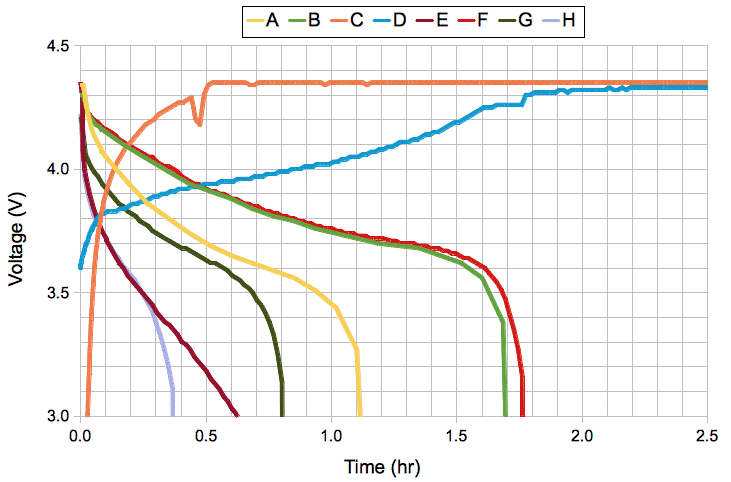The data sheets give a maximum charging current of 9 mA and 80 mA for the small and large batteries respectively. We begin by charging the small battery at 20 mA and the large one at 150 mA until the battery voltages reach 4.3 V. We discharge both with resistors, and we find that the battery capacity is roughly half nominal.
We now charge the batteries by the rapid-charge procedure specified by their data sheets. We supply 9 mA to the small battery and 150 mA to the large battery until their voltages reach 4.3 V, then we apply constant voltage of 4.3 V until the battery current drops to 10% of the rapid charge current. After two hours, both batteries appear to be fully charge. We discharge them with resistors. The graph below shows the small battery discharging through a 200-Ω resistor (A) and the large battery discharging through a 40-Ω resistor (B).

Figure: Charging and Discharging Lithium-Ion batteries. Lines A and B showing the discharge of the small battery through 200 Ω and the large battery through 40 Ω. Lines C and D show the small and large battery charging up to 4.3 V. Lines E and F another discharge with the same resistors. Line G is the large battery discharging through 20 Ω, and H is discharging through 10 Ω.
At 3.7 V the discharge currents (A and B) are 18 mA and 92 mA respectively. While discharging to 3.0 V, the small battery delivers 20 mA-hr and the large one delivers 160 mA-hr. The small battery discharges completely to 0.0 V through the 200-Ω resistor. The large battery is equipped with a protection circuit that disconnects it from the 40-Ω resistor when the battery voltage drops below 3.0 V.
We recharge the large battery at 150 mA (C) and the small battery at 9 mA (D). We discharge through the same resistors (E and F). The large battery provides 162 mA-hr but the small battery provides only 11 mA-hr. The small battery has been damaged by its complete discharge to 0.0 v. We re-charge the large battery and discharge it through 20 Ω (G). At 3.7 V, the discharge current is 185 mA. The battery provides 148 mA-hr. We re-charge and discharge through 10 Ω (H). At 3.7 V, the discharge current is now 370 mA and the battery still provides us with 130 mA-hr.
Lithium-ion battery data denote the nominal capacity of a battery in mA-hr with the letter C. For our large battery, C = 150 mA-hr. The rapid charge current is 1.0C mA = 150 mA. The maximum discharge current is 160 mA, which is 1.1C mA. The smaller battery has C = 19 mA-hr, but its rapid charge current is only 0.5C, or 9 mA, and its maximum discharge current is also 0.5C.
It takes one or two hours to charge a lithium-ion battery to its nominal capacity 1.0C. When we discharge at 1.0C mA, the capacity drops to 0.9C mA-hr, and discharging at 2.0C mA, the capacity drops to 0.8C mA-hr. If we allow the battery to discharge completely to 0.0 V, it loses over half its capacity. Thus we can draw 38 mA continuously from our 19 mA-hr miniature lithium-ion battery and still obtain 15 mA-hr of battery life.
No comments:
Post a Comment